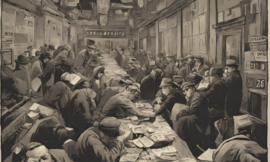Miguel de Cervantes Saavedra, the celebrated 16th-century Spanish author of Don Quixote de la Mancha, once said that “the gratification of wealth is not found in mere possession or in lavish expenditure, but in its wise application.” Little did he know that his wisdom would extend beyond the pages of his literary masterpiece to unravel a perplexing economic phenomenon that haunts nations to this day. Welcome, dear readers, to the enigmatic world of Dutch Disease!
In the swinging 60s, the Netherlands stumbled upon a treasure trove beneath the serene North Sea – vast natural gas deposits. The nation’s coffers swelled, and the Dutch people rejoiced. But beneath the surface of prosperity lurked a shadowy curse. The Dutch guilder grew stronger, casting its ominous shadow over the country’s non-oil exports, rendering them as attractive as a soggy tulip. This, my friends, is the essence of Dutch Disease – an affliction where newfound riches bring unforeseen troubles.
Dutch Disease, though rooted in history, is a modern-day enigma that can strike when you least expect it. It’s not just about the sudden windfall of natural resources; it can take many forms. Imagine a lavish party where you win a colossal jackpot. Ecstasy, right? Well, not if your newfound wealth attracts uninvited attention and drives up the prices of everything you desire. In this scenario, you’d soon be longing for the days when your pockets weren’t bursting with cash. That’s Dutch Disease in a nutshell – a paradoxical conundrum where the boon of one sector causes the bane of others.
The Dutch Disease terminology made its debut in The Economist magazine in 1977, inspired by the Netherlands’ economic turmoil following their natural gas bonanza in 1959. While natural gas exports filled the Dutch treasury, the simultaneous appreciation of their currency led to an economic quagmire. Unemployment soared, and the manufacturing sector withered away like a desert flower.
Now, you might wonder: why does this Dutch Disease even matter? Well, it’s all about specialization and balance. Economists advocate the idea of comparative advantage, where each country should excel in what it does best. But Dutch Disease scoffs at this principle, especially when a nation’s fortune rides solely on natural resources. Picture a circus performer who can juggle flaming torches with finesse but falters when handed a sword. That’s what happens when an economy hinges on a single act.
The mechanics of Dutch Disease are devilishly intricate. The industries tied to natural resources, like mining, are capital-intensive but lack labor requirements. This lures foreign investment, causing the domestic currency to rise. A stronger currency is both a blessing and a curse, making domestic exports more expensive while imported goods flood in like a tidal wave.
To dodge Dutch Disease, nations have two primary strategies up their sleeves:
1. Deceleration of Domestic Currency Appreciation: Think of this as maintaining an economic equilibrium. It involves prudent management of windfall gains, perhaps channeling them into a sovereign wealth fund. Countries like Australia, Canada, Norway, and Russia have successfully deployed this strategy, smoothing out currency appreciation and investing excess revenues in education or infrastructure to diversify their economies.
2. Diversification of the Economy: Instead of putting all your eggs in one basket, spread them around! Governments can nurture lagging sectors through subsidies or protect domestic producers with tariffs. This strategy effectively ensures that the economy doesn’t become a one-trick pony.
Now, let’s fast-forward to recent history. In the 1970s, the United Kingdom was hit by a bout of Dutch Disease when the price of oil skyrocketed, thanks to North Sea Oil. As the pound sterling soared, the country plunged into recession. British workers demanded higher wages, and other exports lost their competitive edge.
Canada also danced with the Dutch Devil. In 2014, the influx of foreign capital from oil sands exploitation inflated the Canadian dollar and sapped the competitiveness of the manufacturing sector. Simultaneously, the Russian ruble experienced a similar fate. The fall in oil prices in 2016 acted as a respite, leveling the playing field.
In conclusion, Dutch Disease is not a relic of the past but a phenomenon that lurks in the shadows of economic prosperity. It teaches us that wisdom in wealth lies not just in its possession but in its judicious application. So, as we navigate the treacherous waters of economic fortune, let us heed the lessons of Dutch Disease and strive for a diversified and balanced future. After all, it’s not just about the riches we amass but how wisely we wield them that truly matters.


